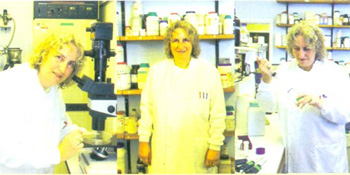By Philippa Darbre
School of Biological Sciences, University of Reading.
Finding a lump in the breast is a scary event for any woman in today’s world. Fears inevitably flood in, even if we remind ourselves that most lumps are benign. Then, if the diagnosis confirms that it is just a breast cyst and the fluid can be removed by aspiration, what a sense of relief. However, gross cystic breast disease is the most common benign breast disorder giving large numbers of women this scare every year, and the causes seem to be unknown.
On the basis that antiperspirant formulations are designed to block underarm sweat ducts and breast cysts result from blocked breast ducts, I have suggested previously that breast cysts might also arise from antiperspirant use (1-3). The most commonly used active antiperspirant agents are aluminium salts, which act to prevent sweat from escaping onto the skin surface through the formation of a physical plug in sweat duct (4). Excessive application of antiperspirant agents beyond the underarm to adjacent breast areas could result in absorption of aluminium salts and deposition in underlying breast tissues, which might give rise to subsequent blockage of breast ducts if sufficient chemicals are absorbed or accumulated over long periods of useage. Levels of absorption might be further increased if the skin is shaved prior to cosmetic application since shaving can create nicks in the skin and so allow easier access for chemicals.
If aluminium-based antiperspirant salts play any role in breast cyst formation, then it might be expected that aluminium would be detectable in breast cyst fluid at raised levels. A recent study from Professor Mannello and Dr Tonti of the University of Urbino in Italy (5) has indeed found that aluminium levels in 48 samples of breast cyst fluids were significantly higher than levels of aluminium found in human blood and by up to 50-fold. This study cannot identify where the aluminium originated from and it remains to be established why the levels of aluminium were so high in some of the cyst fluids. However, if aluminium-based antiperspirants are found to be the source and to play any causal role in breast cyst formation, then it might become possible to prevent this common breast disorder by personal decision to stop using these products.
It remains in dispute as to whether breast cyst formation is linked or not to a subsequent risk of breast cancer development. It is certainly not a pre-cancerous state per se but the many studies which do find a link suggest that some women with a history of breast cyst formation could be at higher risk of subsequent breast cancer development. It is also important to realise that most cysts develop in women between the ages of 35-50 before the majority of breast cancers develop later in the over 50 age group. If breast cysts are caused in any way by excessive antiperspirant use, then breast cyst development might be a wake-up call to reduce or stop using these products. As for breast cancer, breast cysts are also more frequent in the upper outer quadrant of the breast, just the local area to which these products are applied. Although mechanisms will be different, if cosmetic chemicals are involved in any way in both breast cyst and breast cancer development, then the formation of breast cysts in an earlier age group may simply be a warning sign to be ignored at your own risk.
Unlike for breast cancer, statistics for the frequency of breast cyst development are not routinely monitored. Since breast cancer incidence is rising annually and since breast cyst formation has been cited as occurring at approximately three times the frequency of breast cancer, one might guess that there are now over 100,000 new cases of breast cyst development in the UK each year. It is time to ask ‘Why?’ I was alerted to the possibility of a link between antiperspirant use and breast cyst formation by several women (some UK and some outside the UK) who kindly wrote to me telling me of their personal experience that when they stopped using antiperspirant that breast cysts went down or stopped recurring. If you have any experience of this, I would very much like to receive an e-mail from you – if I receive enough of such testimonies then the link would become more convincing. Would it not be wonderful if to stop this breast disease all we needed to do would be to simply stop using antiperspirant? If you have had a previous history of breast cysts, would you be prepared to try?
References:
1. Darbre PD. 2001. Underarm cosmetics are a cause of breast cancer. European Journal of Cancer Prevention 10, 389-393.
2. Darbre PD. 2003. Underarm cosmetics and breast cancer. Journal of Applied Toxicology 23, 89-95.
3. Darbre PD. 2006. Environmental oestrogens, cosmetics and breast cancer. Best Practice & Research in Clinical Endocrinology and Metabolism 20, 121-143.
4. Laden K, Felger CB. 1988. Antiperspirants and Deodorants. Cosmetic Science and technology series vol 7, Marcel Dekker: New York.
5. Mannello F, Tonti GA, Darbre PD. 2009. Concentration of aluminium in breast cyst fluids collected by women affected by gross cystic breast disease. Journal of Applied Toxicology 29 (No 1) [EPubAhead of print